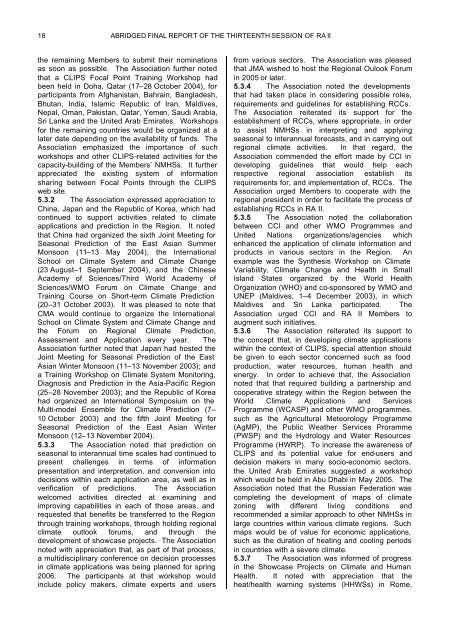Regional Association II (ASIA) - E-Library - WMO
Regional Association II (ASIA) - E-Library - WMO
Regional Association II (ASIA) - E-Library - WMO
You also want an ePaper? Increase the reach of your titles
YUMPU automatically turns print PDFs into web optimized ePapers that Google loves.
18 ABRIDGED FINAL REPORT OF THE THIRTEENTH SESSION OF RA <strong>II</strong>the remaining Members to submit their nominationsas soon as possible. The <strong>Association</strong> further notedthat a CLIPS Focal Point Training Workshop hadbeen held in Doha, Qatar (17–28 October 2004), forparticipants from Afghanistan, Bahrain, Bangladesh,Bhutan, India, Islamic Republic of Iran, Maldives,Nepal, Oman, Pakistan, Qatar, Yemen, Saudi Arabia,Sri Lanka and the United Arab Emirates. Workshopsfor the remaining countries would be organized at alater date depending on the availability of funds. The<strong>Association</strong> emphasized the importance of suchworkshops and other CLIPS-related activities for thecapacity-building of the Members’ NMHSs. It furtherappreciated the existing system of informationsharing between Focal Points through the CLIPSweb site.5.3.2 The <strong>Association</strong> expressed appreciation toChina, Japan and the Republic of Korea, which hadcontinued to support activities related to climateapplications and prediction in the Region. It notedthat China had organized the sixth Joint Meeting forSeasonal Prediction of the East Asian SummerMonsoon (11–13 May 2004), the InternationalSchool on Climate System and Climate Change(23 August–1 September 2004), and the ChineseAcademy of Sciences/Third World Academy ofSciences/<strong>WMO</strong> Forum on Climate Change andTraining Course on Short-term Climate Prediction(20–31 October 2003). It was pleased to note thatCMA would continue to organize the InternationalSchool on Climate System and Climate Change andthe Forum on <strong>Regional</strong> Climate Prediction,Assessment and Application every year. The<strong>Association</strong> further noted that Japan had hosted theJoint Meeting for Seasonal Prediction of the EastAsian Winter Monsoon (11–13 November 2003); anda Training Workshop on Climate System Monitoring,Diagnosis and Prediction in the Asia-Pacific Region(25–28 November 2003); and the Republic of Koreahad organized an International Symposium on theMulti-model Ensemble for Climate Prediction (7–10 October 2003) and the fifth Joint Meeting forSeasonal Prediction of the East Asian WinterMonsoon (12–13 November 2004).5.3.3 The <strong>Association</strong> noted that prediction onseasonal to interannual time scales had continued topresent challenges in terms of informationpresentation and interpretation, and conversion intodecisions within each application area, as well as inverification of predictions. The <strong>Association</strong>welcomed activities directed at examining andimproving capabilities in each of those areas, andrequested that benefits be transferred to the Regionthrough training workshops, through holding regionalclimate outlook forums, and through thedevelopment of showcase projects. The <strong>Association</strong>noted with appreciation that, as part of that process,a multidisciplinary conference on decision processesin climate applications was being planned for spring2006. The participants at that workshop wouldinclude policy makers, climate experts and usersfrom various sectors. The <strong>Association</strong> was pleasedthat JMA wished to host the <strong>Regional</strong> Oulook Forumin 2005 or later.5.3.4 The <strong>Association</strong> noted the developmentsthat had taken place in considering possible roles,requirements and guidelines for establishing RCCs.The <strong>Association</strong> reiterated its support for theestablishment of RCCs, where appropriate, in orderto assist NMHSs in interpreting and applyingseasonal to interannual forecasts, and in carrying outregional climate activities. In that regard, the<strong>Association</strong> commended the effort made by CCl indeveloping guidelines that would help eachrespective regional association establish itsrequirements for, and implementation of, RCCs. The<strong>Association</strong> urged Members to cooperate with theregional president in order to facilitate the process ofestablishing RCCs in RA <strong>II</strong>.5.3.5 The <strong>Association</strong> noted the collaborationbetween CCl and other <strong>WMO</strong> Programmes andUnited Nations organizations/agencies whichenhanced the application of climate information andproducts in various sectors in the Region. Anexample was the Synthesis Workshop on ClimateVariability, Climate Change and Health in SmallIsland States organized by the World HealthOrganization (WHO) and co-sponsored by <strong>WMO</strong> andUNEP (Maldives, 1–4 December 2003), in whichMaldives and Sri Lanka participated. The<strong>Association</strong> urged CCl and RA <strong>II</strong> Members toaugment such initiatives.5.3.6 The <strong>Association</strong> reiterated its support tothe concept that, in developing climate applicationswithin the context of CLIPS, special attention shouldbe given to each sector concerned such as foodproduction, water resources, human health andenergy. In order to achieve that, the <strong>Association</strong>noted that that required building a partnership andcooperative strategy within the Region between theWorld Climate Applications and ServicesProgramme (WCASP) and other <strong>WMO</strong> programmes,such as the Agricultural Meteorology Programme(AgMP), the Public Weather Services Proramme(PWSP) and the Hydrology and Water ResourcesProgramme (HWRP). To increase the awareness ofCLIPS and its potential value for end-users anddecision makers in many socio-economic sectors,the United Arab Emirates suggested a workshopwhich would be held in Abu Dhabi in May 2005. The<strong>Association</strong> noted that the Russian Federation wascompleting the development of maps of climatezoning with different living conditions andrecommended a similar approach to other NMHSs inlarge countries within various climate regions. Suchmaps would be of value for economic applications,such as the duration of heating and cooling periodsin countries with a severe climate.5.3.7 The <strong>Association</strong> was informed of progressin the Showcase Projects on Climate and HumanHealth. It noted with appreciation that theheat/health warning systems (HHWSs) in Rome,
















